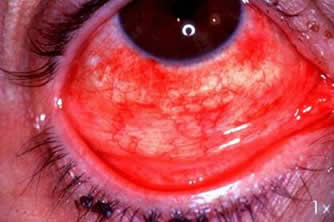Introduction
Conjunctivitis is an inflammation of the conjunctiva, the transparent membrane that lines the white of the eyeball. The most common cause of conjunctivitis is a bacterial or viral infection. Other causes include seasonal allergies and reactions to eye medications.

Photograph of eye with viral conjunctivitis (eye redness with tearing)

Photograph of eye with bacterial conjunctivitis (redness with discharge)

Photograph of eye with allergic conjunctivitis
Signs & symptoms
Symptoms of conjunctivitis can occur in one or both eyes. They include:
- Redness,
- Discharge (either watery, mucus or yellowish depending on causes)
- Gritty sensation,
- Sometimes itchiness (especially in allergic conjunctivitis)
- Light sensitivity (photophobia).
- It can occur in one eye or both.
Complications
Some conjunctivitis may lead to corneal complications. If you have pain, decreased vision, or a strong light sensitivity associated with your symptoms of a red eye, you are likely to have a condition more serious than conjunctivitis. In this situation you should see an ophthalmologist.
Treatment
Treatment varies depending on the specific cause of conjunctivitis. Symptoms due to viral conjunctivitis will be relieved by application of a cool wet cloth 3-4 times a day and applying artificial tears. If there is a suspicion of bacterial conjunctivitis; antibiotic drops or ointment are usually given. Allergic conjunctivitis may be relieved by topical anti-histamine or topical mast cell stabilizer.
Prevention
Conjunctivitis can be transmitted from one person to another by casual contact, sharing towels or pillow cases, facial contact, or sharing of cosmetics. It can occur before, during, or after a cold or upper respiratory infection because the same virus which causes the cold can also cause conjunctivitis.
Thus, important precautions in preventing spreading of infection should be practice. These include:
- Strict with hand-washing. Always wash hands with soap and water before and after touching the eyes.
- Avoid any facial contact with others while you are having symptoms.
- Don’t let others use your personal articles such as towels, pillows, or cosmetics.
- Do not share eye drops or ointment
- Throw away left over eye drops or ointment once symptoms subsided
- If you are a contact lens wearer, you should not wear contact lenses while you have any symptoms.
- People who provide healthcare, food services, or education should not work until their eyes feel and look normal because of the risk of spreading the infection to others.
| Last reviewed | : | 23 August 2019 |
| Writer/Accreditor | : | Dr. Joseph Vijaya Alagaratnam |
| Reviewer | : | Dr. Rosniza bt. Ab. Razak |







